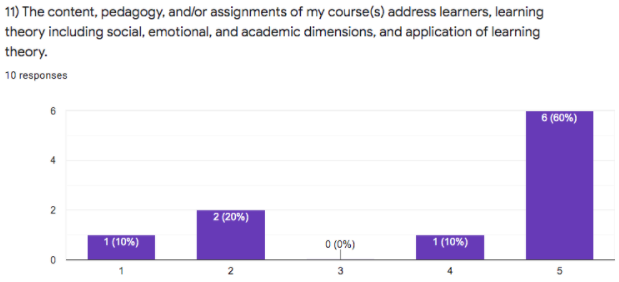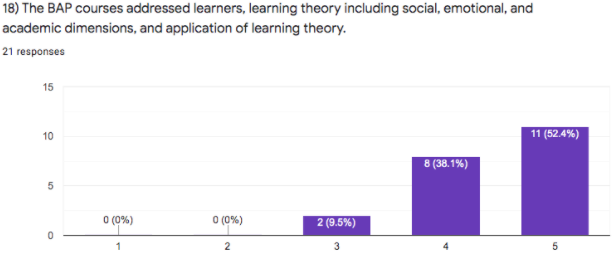AAQEP Accreditation
Standard 1 Aspect B
Standard 1b - Evidence shows that, by the time of program completion, candidates exhibit knowledge of learners, learning theory including social, emotional, and academic dimensions, and application of learning theory.
The Bilingual Authorization Program (BAP) selected three (3) different measures to examine how it prepares candidates with knowledge of learners, learning theory and application of theory relevant to their preparation as bilingual teacher candidates. The first measure comes from the LEE 159 course, the second from the BAP faculty survey and the third measure comes from the BAP completer survey.
Data Sources & Analysis
Data Source 1
LEE 136: Literacy, Language, and Culture Project with Focal Student
Definition of Data Source:
LEE 136 course is taken by all BAP candidates in their first semester in the multiple
subject credential program. This course fulfills California’s English Language (EL)
authorization which indicates that our program completers are prepared to provide
instruction to emergent bilingual children with an emphasis on helping them learn
to read, write, and speak in English. As noted on the course syllabus students spend
six (6) weeks learning about first, second, and bilingual acquisition language theories
as well as the sociocultural and political context of bilingual/dual immersion learning.
To further develop their learning about learners, candidates complete a literacy, language, and culture project with a focal student. In this assignment, candidates identify one focal student to observe and get to know, preferably a child who is labeled Emergent Bilingual (also called English Language Learner (ELL)). Candidates work alongside their focal student and learn about her/his interests, literacy, language, and culture. They are required to take detailed notes about their conversations after all interactions and then discuss the student’s profile during class time. At the end of the semester, candidates prepare a shadowbox with their student and submit a 1-page, single-spaced narrative about the student.
Specific Elements of Data Source:
Students’ overall grade on assignment
(Unfortunately, scores were not broken down by rubric criterion, and so holistic scores
must be used)
Definition of Success for Each Element:
Programmatically, our goal was for each candidate to score at least an 8 on this assignment
in order to demonstrate competency.
Displays of Analyzed Data:
| User ID | Literacy, Language, and Culture Story/Project with Focal Student |
|---|---|
| Student 1 | 10 |
| Student 2 | 10 |
| Student 3 | 10 |
| Student 4 | 10 |
| Student 5 | 10 |
| Student 6 | 10 |
| Student 7 | 9 |
| Student 8 | 10 |
| Student 9 | 10 |
| Student 10 | 10 |
| Student 11 | 10 |
| Student 12 | 10 |
| Student 13 | 10 |
| Student 14 | 8 |
| Student 15 | 10 |
| Student 16 | 10 |
| Student 17 | 10 |
| Student 18 | 10 |
| Student 19 | 10 |
| Student 20 | 10 |
| Student 21 | 10 |
| Student 22 | 10 |
| Student 23 | 10 |
Link to Full Dataset: LEE136 Gradebook
Interpretation of Data:
Programmatically, our goal was for students to attain at least a B average on this
assignment, however, the average for this assignment was a 9.9/10 as evidenced by
the gradebook. This demonstrates that candidates did develop knowledge of learners and practice
applying their knowledge of learning theory through their interaction with their student.
Data Source 2
BAP Faculty Survey
Definition of Data Source:
The second source of data comes from the BAP faculty survey that was created and disseminated
for the first time in Spring 2021, with the purpose of examining faculty’s perspectives
on how each course meets the state bilingual authorization standards, as well as AAQEP
standard 1 items a-f.
Starting during the 2021-2022 and thereafter, the results from this survey will be analyzed and discussed in the program advisory meetings to ensure the interest of all stakeholders are represented in coursework and that streamlining of each course is maintained.
For each item, faculty were asked to rate the extent to which they agree with the statement on a Likert scale of 1-5, with 1 being strongly disagree and 5 being strongly agree.
Perspective Captured from Data Source: Faculty
Rationale for using Data Source:
This survey was created to gather faculty members’ perspectives on how well course
content aligns with the aspects of AAQEP Standard 1.
Specific Elements of Data Source:
Item 11: The content, pedagogy, and/or assignments of my course(s) address learners,
learning theory including social, emotional, and academic dimensions, and application
of learning theory
Definition of Success for Each Element:
The goal of the program is to have all faculty members strongly agree that their courses
align with the AAQEP Standard 1 aspects.
Displays of Analyzed Data:

Link to Full Dataset: BAP Faculty Survey
Interpretation of Data:
Responses indicate that 70% of faculty agreed or strongly agreed, while 30% disagreed
or strongly disagreed with this statement.
Data Source 3
BAP Completer Survey
Description of Data Source:
The second measure for standard 1b comes from the BAP completer survey completed by
21 graduates for the spring 2021 term. The purpose for this survey is to understand
graduates' experiences in the BAP and Multiple Subject credential program as well
as employment outcomes. Moving forward, data from this survey will be analyzed and
discussed in the program advisory committee meetings with the purpose of making the
necessary changes to improve the program and to better serve our students and the
interests of stakeholders, such as district partners.
Only one (1) year of completer data is available because this is the first time a completer survey was created and disseminated among program graduates. Prior to the new coordinator’s leadership, the BAP was a very small program and no completer data was collected.
Perspective Captured from Data Source: Program Completer
Rationale for using Data Source:
The survey provides information about the program from the perspective of program
completers who are now in the teaching profession.
Specific Elements of Data Source Using:
Item 18: The BAP courses addressed learners, learning theory including social, emotional,
and academic dimensions, and application of learning theory
Definition of Success for Each Element:
Completers are asked to rate the extent to which they agree with each statement on
a 1 (strongly disagree) to 5 (strongly agree) point Likert scale, with the programmatic
goal being a score of 4.
Displays of Analyzed Data:

Link to Full Dataset: BAP completer raw data
Interpretation of Data:
Responses indicate that 90.5% of students agreed or strongly agreed, while only 9.5%
were neutral on this statement.
Analysis and Next Steps:
Analysis of the BAP faculty and completer survey responses indicate that the program
courses are doing a great job in addressing learners, learning theory and theory application.
However, the 30% of faculty who disagreed or strongly disagreed merit attention and
further investigation. As mentioned in the introduction, the recent redesign of both
the Spanish and Hmong BAP pathways will focus on ensuring that we work towards embedding
a variety of learning theories relevant to the preparation of bilingual/dual immersion
teachers in each of the courses. To evaluate our efforts in this area, the program
coordinator will provide curriculum support to all program faculty and will also engage
program faculty and advisory board members in yearly curriculum evaluation during
program meetings that will ensure program courses discuss learning theories relevant
to the preparation of bilingual/dual immersion teachers.